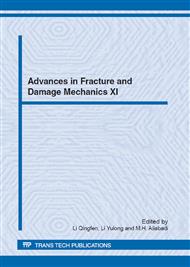p.1
p.5
p.9
p.13
p.17
p.21
p.25
p.29
A Grain Boundary Formulation for the Analysis of Three-Dimensional Polycrystalline Microstructures
Abstract:
A 3D grain boundary formulation is presented for the analysis of polycrystalline microstructures. The formulation is expressed in terms of intergranular displacements and tractions, that play an important role in polycrystalline micromechanics, micro-damage and micro-cracking. The artificial morphology is generated by Hardcore Voronoi tessellation, which embodies the main statistical features of polycrystalline microstructures. Each crystal is modeled as an anisotropic elastic region and the integrity of the aggregate is restored by enforcing interface continuity and equilibrium between contiguous grains. The developed technique has been applied to the numerical homogenization of cubic polycrystals and the obtained results agree well with available data.
Info:
Periodical:
Pages:
1-4
Citation:
Online since:
November 2012
Authors:
Price:
Сopyright:
© 2013 Trans Tech Publications Ltd. All Rights Reserved
Share:
Citation:


